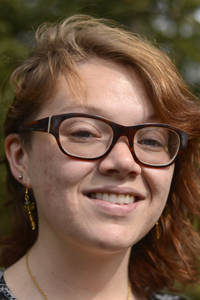“You’re OK,” I told myself over and over again, a mantra more wish than fact. I was not OK, in fact. I was hanging off the side of a sheer slope with my terrified hands clutching an alder branch, bashing my toes into the crusty snow on my way to the top of a ridge on Mount Marathon. Turning around wasn’t an option, because if I looked down that 50-foot drop, I’d really be done in.
That wasn’t the first time I’d been in that spot. The panic welling in my throat was an old friend, born in the dizzying moments at the edge of a diving board or on a trail overlooking the red-rock walls of the Grand Canyon. It visited again when I drank beers on rooftops in college in Chicago and when I climbed hundreds of stairs to the top balcony at St. Paul’s Cathedral in London, so far above the safety of knowing there was nowhere to fall.
“You’re OK,” I would tell myself, and after a moment, it would be true. I would turn back and my heart would slow again.
I’ve never been the bravest person in the world, but my approach to adventure has been affectionately described as “reckless.” My friend and I regularly wind up off the map when we hike, resulting in miles of bushwhacking through alders and knee-deep snow. I once decided to hike to Juneau Falls in the winter by myself, realized early that I had taken the wrong trail but assumed if I followed the shape of the mountains, I’d find it eventually. (I did, but only with the help of some friendly skiers.) Those times, the mantra became a prediction, as if I’d always known how it would turn out.
But there are others, too.
“You’re OK,” I remember telling myself as I meandered through the woods as a 12-year-old, completely lost. Out for a group paintball game in the forests surrounding my hometown of Prescott, Arizona, I had been shot and told to head back to camp. Unfortunately, I was born with a sense of adventure, not a sense of direction, and headed exactly the wrong way.
Two hours later, trying to stave off tears, I had managed to find a disused forest service road and began wandering down it. A distant voice filtered through the trees, and soon enough, my wild-eyed father came lumbering toward me. Vividly, I remember the scratch of his cheek on mine and the smell of pine sap as he held me, repeating softly, “Never again, never again.”
Wild adventures are alluring until they have a cost. My own somewhat reckless father learned that at 18 years old, falling from a bridge into an empty Arizona riverbed and breaking nearly every bone in his body. The resulting damage robbed him of nearly every activity he loved — rock climbing, caving, hiking, swimming — and left him with a body he jokingly described as half metal. I knew my father often by the things he could not do. Sometimes when he moved, his smile hid a wince.
And yet, the sense of adventure refused to die. His passion for bicycling inspired a lifelong love of the sport in me. I seem to have inherited his temperament, despite it having been taken long before I was born.
But I’m reminded of the years of pain he endured every time I find myself in a hairy situation, having to hope and wish everything will be fine. I’m reminded of the danger of my temperament every time I read a story about an experienced climber who fell from a cliff to his death, despite his gear, despite the clear weather. I’m reminded of the world’s wild side every time I look down the edge of a cliff and know in my blood and my brain: This could be it for me.
So, as I scrambled my way up into the bowl on Mount Marathon toward my boyfriend, who kept reminding me that I was doing fine, that I was almost there, the mantra came with a measure of humility and a reminder to take care — the consequences of accidents fall on more than just victims.
I reached the top and buried my face in my hands to slow my heart. “You’re OK,” I told myself, and it was true — this time.
Elizabeth Earl is a reporter at the Peninsula Clarion. Reach her at elizabeth.earl@peninsulaclarion.com.

